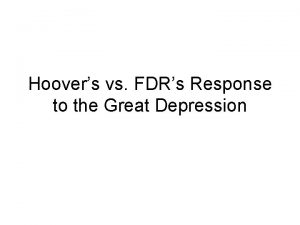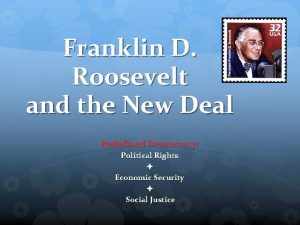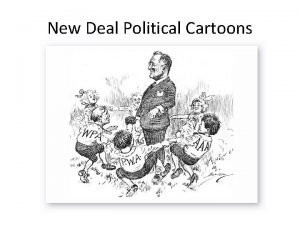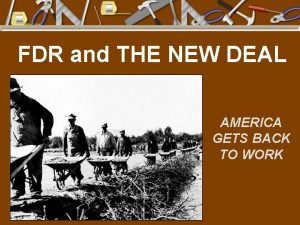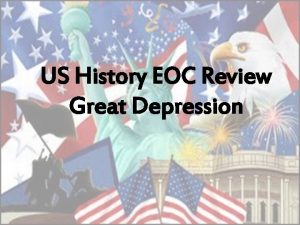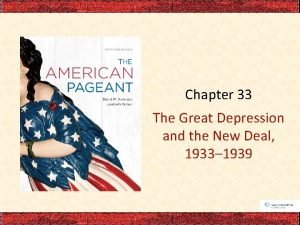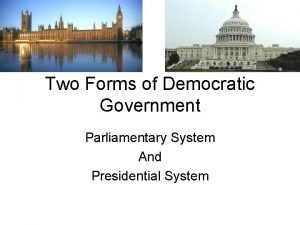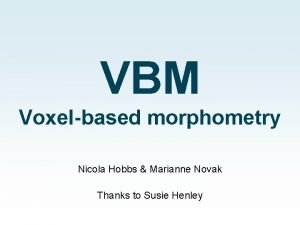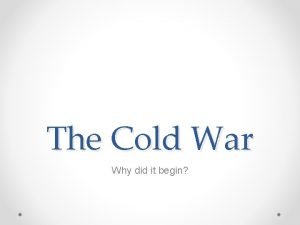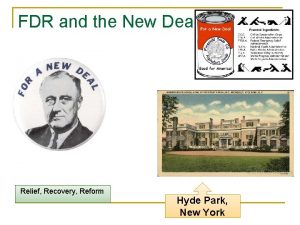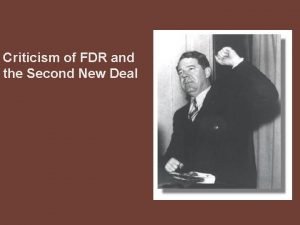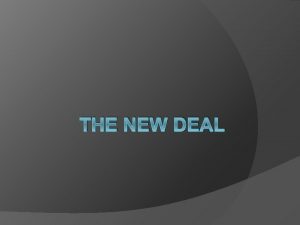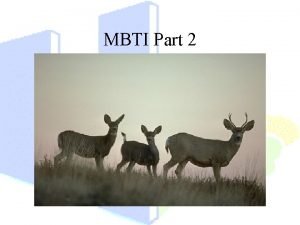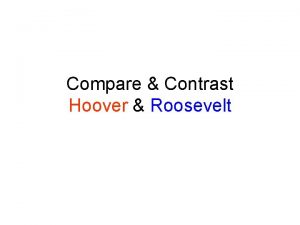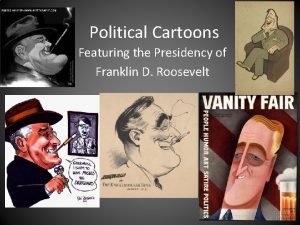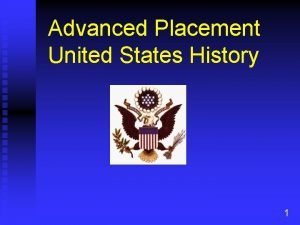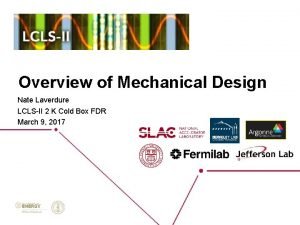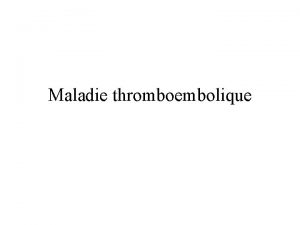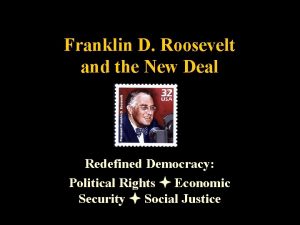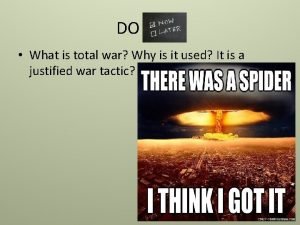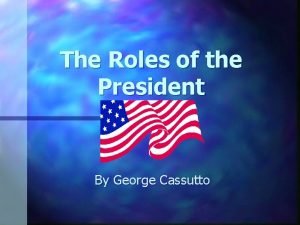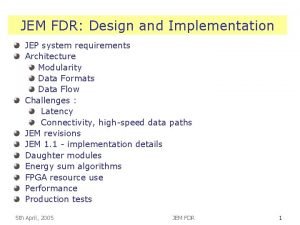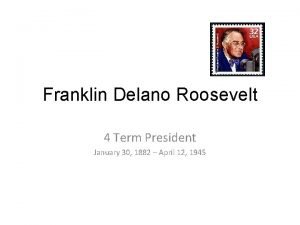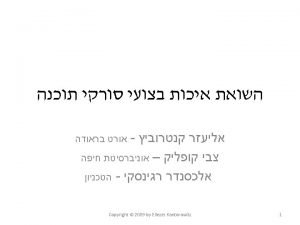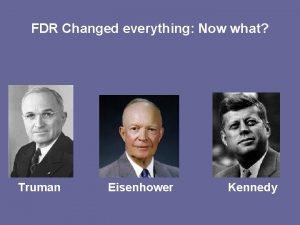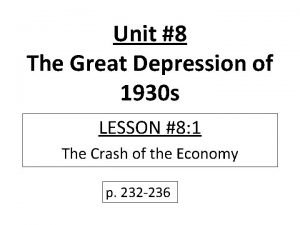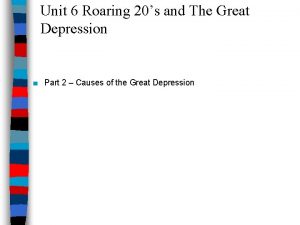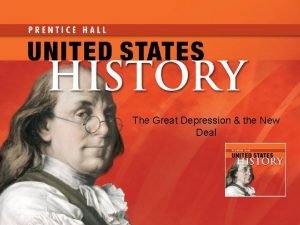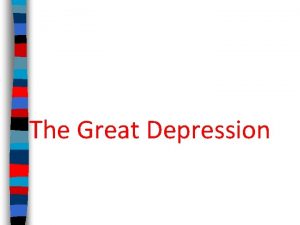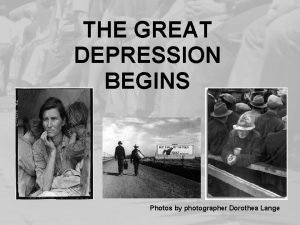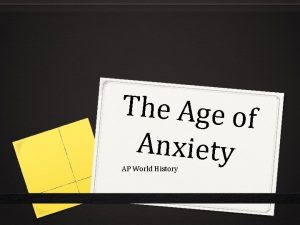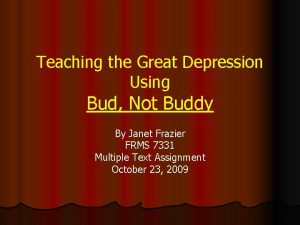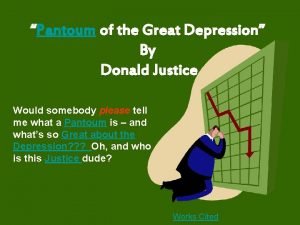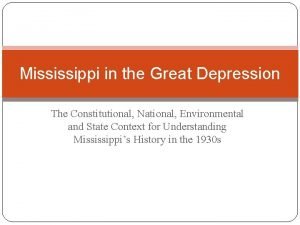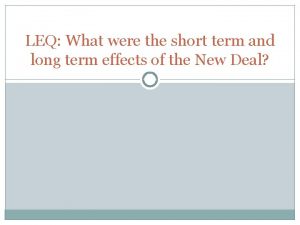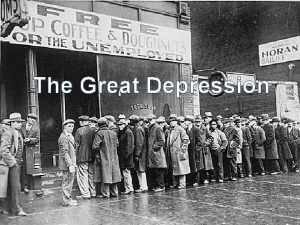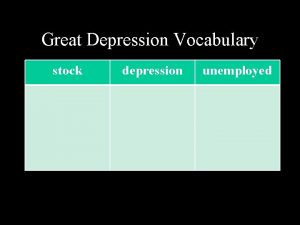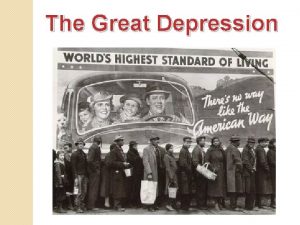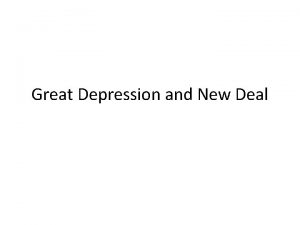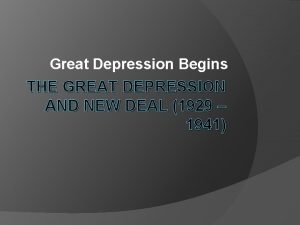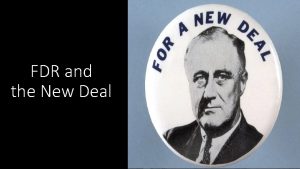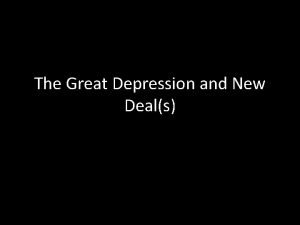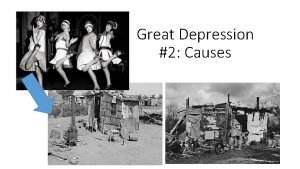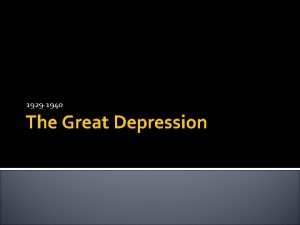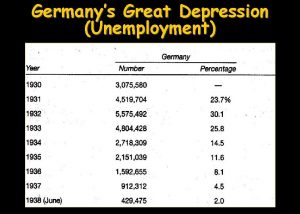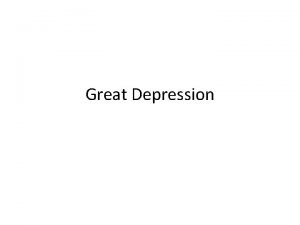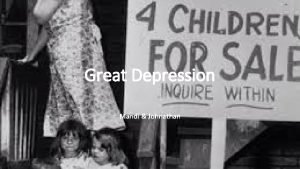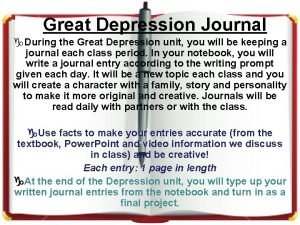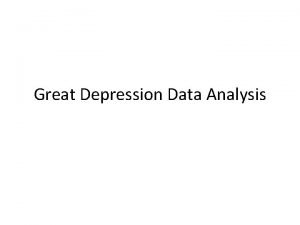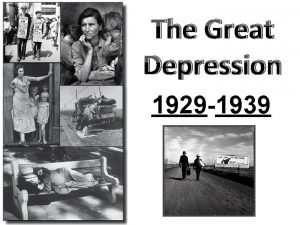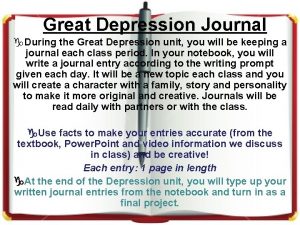Great Depression FDR the New Deals Redefined Democracy







































- Slides: 39

Great Depression: FDR & the New Deal(s) Redefined Democracy: Political Rights Economic Security Social Justice

Causes of the Great Depression • Agricultural ________ • Industrial _________ • Unequal distribution of wealth • ______________ • International economic situation • _____________

How Herbert Hoover Dealt with the Crisis • He played the game of confidence economics and just kept saying: “Prosperity is right around the corner. ”

Voluntary Measures • Hoover eventually established two privatelyfunded organizations: • The _________________provided $1/2 billion to businesses for emergency loans, but it was too under-funded to do much good. • _____________________was a clearing house for relief agencies. However, state and local governments were already in too much debt to benefit from it.

Limited Government Intervention • In the end, Hoover resorted to government intervention: • ___________________gave $1 -1/2 billion in federal loans to banks, insurance companies, and industry to prevent bankruptcies, but it was too little, too late. “_____________________” • The Home Loan Bank Act provided federal loans to homeowners to prevent foreclosures, but got bogged down in red tape.

Reasons for Ineffectiveness • Hoover thought business should be self-regulating. • _________ • He had a mania for a balanced budget. • He lacked political finesse.

Franklin D. Roosevelt’s Appeal • In 1932 presidential election, FDR was perceived as a man of action. • Hoover was viewed as a “do-nothing president. ” • Norman Thomas, the Socialist candidate, was viewed as a radical. • Results: a landslide for Democrats and a mandate to use government as an agency for human welfare.


First Hundred Days ÜMarch 9 – June 16, 1933 ÜCongress passed more than ______________ ÜSignificantly expanded the federal government’s role in the nation’s economy

__________– radio talks about issues of public concern; explained New Deal; Americans felt like FDR was speaking directly to them

Prohibition Repealed - 1933 In order to raise government revenues by taxing alcohol; ________ passed

Situation When FDR Entered Office • In March 1933, the country was virtually leaderless and the banking system had collapsed.

FDR _______________ • In his inaugural address, he said “The only thing we have to fear is fear itself…. ” • He promised vigorous leadership and bold action, called for discipline and cooperation, expressed his faith in democracy, and asked for divine protection and guidance.

FDR’s Personal Qualities • He was a practical politician who practiced the art of the possible. • He was a charismatic person who exhibited a warmth and understanding of people. • He knew how to handle press by focusing attention on Washington. • He provided dynamic leadership in a time of crisis. • He was _________

Purposes of the New Deal • ________: to provide jobs for the unemployed and to protect farmers from foreclosure • _________: to get the economy back into high gear, “priming the pump” • _________: To regulate banks, to abolish child labor, and to conserve farm lands • Overall objective: to save capitalism

Sources of New Deal Ideas • Brains Trust: specialists and experts, mostly college professors, idea men • New Economists: government spending, deficit spending and public works, government should prime economic pump • Roosevelt Cabinet: included conservatives, liberals, Democrats, Republicans, inflationists, anti-inflationists -often conflicting, compromising, blending ideas

First ________(1933 -1934) • Emphasis: ________ • Political Position: conservative • Primary aim: economic recovery • Philosophy: economic nationalism and economic scarcity (i. e. , raise prices by creating the illusion of scarcity) • Objectives: higher prices for agriculture and business • Beneficiaries: big business and agricultural business

____________(NRA) • Purpose: recovery of industry • Created a partnership of business, labor, and government to attack the depression with such measures as price controls, high wages, and codes of fair competition

First _________________(AAA) • Purpose: the recovery of agriculture • Paid farmers who agreed to reduce production of basic crops such as cotton, wheat, tobacco, hogs, and corn • Money came from a tax on processors such as flour millers and meat packers who passed the cost on to the consumer

_______________(FERA) • Purpose: relief • Gave money to states and municipalities so they could distribute money, clothing, and food to the unemployed

_______________(CCC) • Purpose: relief • Gave outdoor work to unemployed men between the ages of 17 and 29 • They received $30 per month, but $22 went back to the family

Second _______(1934 -1941) • Emphasis: reform • Political Position: liberal • Primary aim: permanent reform • Philosophy: international economic cooperation and economic abundance • Objectives: increased purchasing power and social security for public • Beneficiaries: small farmers and labor

_______________ • Purpose: reform • Gave money to states for aid to dependent children, established unemployment insurance through payroll deduction, set up old-age pensions for retirees.

____________Act • Purpose: reform • Put restraints on employers and set up a National Labor Relations Board to protect the rights of organized labor to bargain collectively with employers.

Second ____________Act • Purpose: recovery for agriculture • Paid farmers for conservation practices, but only if they restricted production of staple crops.

_________________ • Purpose: recovery and reform • Used federal funds to tear down slums and construct better housing.

The New Deal on Trial • By 1935, political disunity was evident. There were critics on the right and the left. NE W DE AL

Criticisms of Conservative Opponents • Conservative opponents said the New Deal went too far: • • • It was ____________ (killed individualism) It added to the national debt ($35 billion) It wasted money on relief and encouraged idleness It ________________& states rights It increased the power of the Presidency (FDR was reaching toward dictatorship, Congress a rubber stamp, independence of judiciary threatened, separation of powers shattered)

Anti-New Deal Organization • Conservative opponents to the New Deal had an organization called the ____________. They had money but were small in numbers, so FDR was not worried.

Senator Huey Long (LA) • Senator Huey Long said New Deal relief measures were mere crumbs and advocated a share the wealth plan (i. e. , a guaranteed annual income of at least $5, 000 for every American, financed by confiscating wealth of people who made over $5 million per year).


The Election of 1936 % Popular Vote Electoral Votes Democratic 60. 3% 523 Alfred E. Landon Republican 36. 56% 8 William Lemke 1. 93% Candidate FDR Party Radical Norman Thomas Socialist Earl Browder Communist 0. 41% (2. 21 in 1932) 0. 17 (0. 25 in 1932)

The ____________ • While Republicans were still relying on their traditional base of political support (big business, big farmers, and conservatives), Democrats broadened their constituency by appealing to small farmers in the Midwest, urban political bosses, ethnic blue collar workers, Jews, intellectuals, and African Americans.

Protection of New Deal Accomplishments • Steps FDR took to protect New Deal accomplishments (both failed): • _______________(proposed increasing Supreme Court from 9 to 15 members, caused in revolt in Dem. Party) • Election of 1938 • evidence that FDR interfered in a state campaign upset voters • Republicans gained strength in both houses of Congress

Decline of New Deal Reform after 1937 • ______________made Congress irritable • Recession of 1937 -38 weakened confidence in New Deal measures (spending cuts in order to balance budget), led to Republican strength in Congress • Conservative Democrats ; voted with Republicans to block New Deal legislation • Increasing focus on ____________



Government Expenditures • The total cost of the current bailout now exceeds $4. 6 trillion dollars. It has cost more than all of these government expenditures combined. Figures in parentheses have been adjusted for inflation: • • • Marshall Plan: Cost: $12. 7 billion ($115. 3 billion) Louisiana Purchase: Cost: $15 million ($217 billion) Race to the Moon: Cost: $36. 4 billion ($237 billion) S&L Crisis: Cost: $153 billion ($256 billion) Korean War: Cost: $54 billion ($454 billion) The New Deal: Cost: $32 billion est. ($500 billion est. ) Invasion of Iraq: Cost: $551 billion ($597 billion) Vietnam War: Cost: $111 billion ($698 billion) NASA: Cost: $416. 7 billion ($851. 2 billion) TOTAL: $3. 92 trillion

How does the Great Depression end? Does the bombing of Pearl Harbor by the Japanese pull America from economic crisis? Yes? No? It is still debated today! Pearl Harbor October, 1941
 Fdrs response to the great depression
Fdrs response to the great depression The new deal redefined the role of the
The new deal redefined the role of the Fdr new deal political cartoon
Fdr new deal political cartoon New deal fdr
New deal fdr Aaa new deal logo
Aaa new deal logo Us history eoc review the great depression and the new deal
Us history eoc review the great depression and the new deal Chapter 33 the great depression and the new deal
Chapter 33 the great depression and the new deal Presidential republic
Presidential republic Vbm cross
Vbm cross Fdr
Fdr Examples of relief recovery and reform
Examples of relief recovery and reform Criticism of fdr
Criticism of fdr Fdr
Fdr Artem mbti
Artem mbti Compare and contrast fdr and hoover
Compare and contrast fdr and hoover Fdr political cartoons
Fdr political cartoons Fdr died
Fdr died Fdr
Fdr Fdr thromboembolique
Fdr thromboembolique Tn dams
Tn dams Fdr dies truman becomes president
Fdr dies truman becomes president Franklin d roosevelt chief legislator
Franklin d roosevelt chief legislator Fdr design
Fdr design Franklin roosevelt
Franklin roosevelt Wows fdr
Wows fdr Fdr vps
Fdr vps Rarig great depression
Rarig great depression Great depression
Great depression Sec the great depression
Sec the great depression Foreclosure great depression
Foreclosure great depression Five effects of the great depression
Five effects of the great depression Five effects of the great depression
Five effects of the great depression How did the great depression impact the world
How did the great depression impact the world What is the dawes plan
What is the dawes plan Bud not buddy great depression
Bud not buddy great depression Pantoum of the great depression
Pantoum of the great depression The great depression summary
The great depression summary Cpi during the great depression
Cpi during the great depression Okies great depression
Okies great depression The great depression leq
The great depression leq
